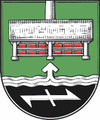Neuwarmbüchen
|
Neuwarmbüchen
Isernhagen municipality
|
||
|---|---|---|
| Coordinates: 52 ° 27 ′ 56 ″ N , 9 ° 53 ′ 27 ″ E | ||
| Height : | 67 m above sea level NHN | |
| Area : | 9.4 km² | |
| Residents : | 2669 (December 31, 2018) | |
| Population density : | 284 inhabitants / km² | |
| Incorporation : | March 1, 1974 | |
| Incorporated into: | Warmbüchen | |
| Postal code : | 30916 | |
| Area code : | 05139 | |
|
Location of Neuwarmbüchen in Lower Saxony |
||
|
Town view
|
||
Neuwarmbüchen is a district of the municipality of Isernhagen in the Hanover region in Lower Saxony .
geography
The district is located northeast of the city of Hanover . The seat of the municipality Isernhagen is with the town hall in Altwarmbüchen .
Neuwarmbüchen is divided into two districts, the old town center and the Gartenstadt Lohne district, which was newly created in the early 1970s . The two districts are not directly adjacent to each other in terms of development and are connected on the one hand by a one-kilometer long footpath and bike path, on the other hand by a spur road of the K 116 district road .
There is a primary school and a kindergarten .
history
The Edder and Flöth brooks flowing through the municipality are fed from various sources . According to tradition, some of these springs would never freeze over and are therefore referred to as warm springs or “warm breaks”. The place name is derived from this. The prefix “New” to “Warmbüchen” leads to the obvious assumption that it is a more recent establishment of the town. However, "Nigen Werenboke", which was indirectly mentioned in a document in 1400, as well as "Nienwarmböken" (document from 1654) belonged to the oldest Isernhagen villages that had already emerged before the systematic colonization. Neuwarmbüchen was built between the 11th and 13th centuries and until the 19th century had around eleven farms . Neuwarmbüchen was owned by the "von Ilten" family until the 17th century. Neuwarmbüchen, like all the villages of today's Isernhagen, was subject to ducal vassals or administrations at the time of the documentary mention . Exceptions to this were the villages of Kirchhorst and Großhorst , which were owned by the von Cramm family . In 1896 the pharmacist, factory owner and politician Gerhard Hoyermann acquired the Lohne estate, which was largely located in the Neuwarmbüchen area. He used it as a test material for the fertilizer Thomas flour he developed .
As part of the regional reform in Lower Saxony , the new community Warmbüchen was formed on March 1, 1974 through the merger of the previously independent communities Neuwarmbüchen, Altwarmbüchen, Kirchhorst and the four old villages of Isernhagen, which later received the final name Isernhagen.
politics
Local council
The local council of Neuwarmbüchen consists of four council women and three councilors. The local council also has two advisory members (CDU, FDP) .
(Status: local election September 11, 2016)
Local mayor
The local mayor is Maren Becker (CDU). Your deputy is Gerd Jaeger (SPD).
coat of arms
The draft emblem of Neuwarmbüchen comes from the in Isernhagen born and later in Hannover living heraldry and crest painter peoples Gustav , who has the coat of arms of Großburgwedel , Melle village , Wunstorf has designed and many other towns. The approval of the coat of arms was given by the district president in Lüneburg on June 1, 1965.
| Blazon : “In green above a silver brick shed with three stands and six red bricks on each of two boards lying on top of one another, behind the roof an excellent chimney. Below above a black shield base , covered with a lying, silver wolf's tang , a silver river with a rising spring . " | |
| Foundation of the coat of arms: The economic life of the community Neuwarmbüchen was previously shaped by the old brickworks for a long time . Bricks have been burned there since the 17th century . For this reason, the Neuwarmbüchen coat of arms also contains a brick shed. Furthermore, a river course is shown, which the nearby river Wietze , which arises from the brooks Edder and Flöth. The wolf angel shown in the lower area of the coat of arms is intended to make it clear that it belongs to the former Burgdorf district , which also has a wolf angel in the coat of arms. |
Culture and sights
literature
- Claudia Kempf-Oldenburg, Jes Tüxen: Isernhagen Chronicle Volume 1 . Ed .: Isernhagen municipality, December 1990.
- Claudia Kempf-Oldenburg, Jes Tüxen: Isernhagen Chronicle Volume 2 . Ed .: Isernhagen municipality, December 1992.
- Heinz Koberg : Our Isernhagen . Ed .: Isernhagen municipality, March 1984.
Web links
Individual evidence
- ↑ a b Facts and Figures. In: Website of the community Isernhagen. December 31, 2018, accessed April 17, 2019 .
- ^ Federal Statistical Office (ed.): Historical municipality directory for the Federal Republic of Germany. Name, border and key number changes in municipalities, counties and administrative districts from May 27, 1970 to December 31, 1982 . W. Kohlhammer GmbH, Stuttgart / Mainz 1983, ISBN 3-17-003263-1 , p. 222 .
- ↑ a b Neuwarmbüchen local council . On: Website of the Isernhagen municipality, accessed on August 14, 2017.
- ↑ District of Hanover: Wappenbuch district of Hanover. Published by the author himself, Hanover 1985.






